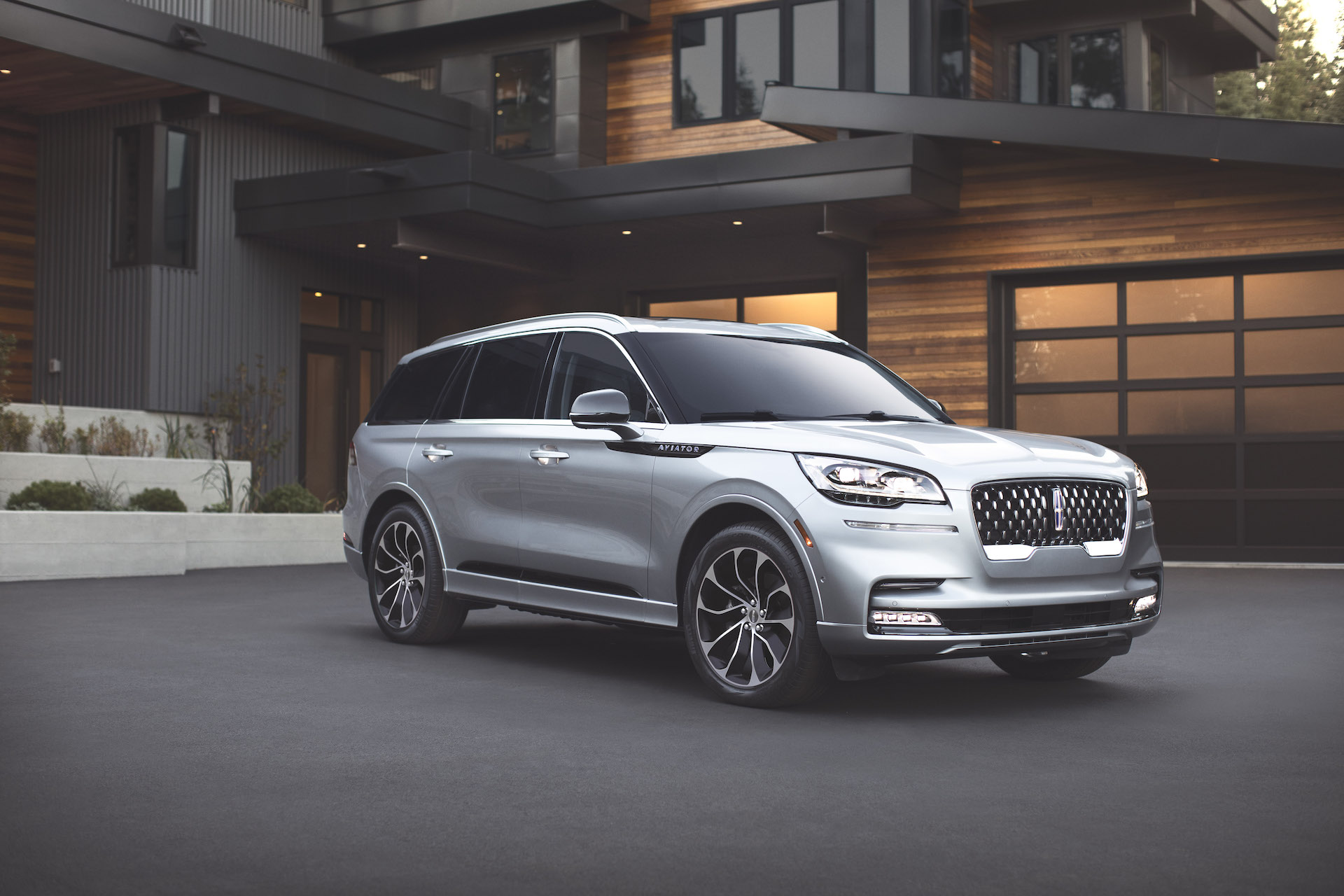
The latest Aviator rides on a new rear-drive architecture that promises deft handling to go with its prodigious twin-turbo power. Weight and height get in the way of its loftiest goals, but the Aviator’s still blessed with good composure.
We give it a 6 for performance. (Read more about how we rate cars.)
Both Aviators tap a 3.0-liter twin-turbo V-6 for power. A bored-out version of Ford’s 2.7-liter V-6 from the F-150 pickup, the Lincoln engine drops the hammer in the Aviator, where it’s rated at 400 horsepower and 415 pound-feet of torque. The sounds that emanate from the V-6 are moany but not groany, and only draw attention at full throttle. Ford doesn’t publish acceleration estimates but this Aviator should reach 60 mph in about 7.5 seconds despite a curb weight of 4,774 lb (4,892 lb with AWD), which nets it a point above average. The 10-speed automatic that delivers power to the rear or all four wheels picks a gear decisively and shifts without much fuss; their small plastic shift paddles behind the steering wheel might go unnoticed.
The Aviator’s unfussy all-wheel-drive system comes standard on most models, and can split power between the front and rear axles, but not side to side as some more complex systems can. The drivetrain has a series of selectable modes which quicken or slow certain responses—Conserve upshifts early to save fuel, while Excite stiffens steering and quickens shifts. The modes change the digital gauge displays, but the Aviator doesn’t have an individual mode, so drivers can’t tailor their own settings as they might in a German SUV at the same price.
The 2020 Aviator also has an automatic tow mode that adapts its drivetrain when a vehicle is hitched; it can tow up to 6,700 pounds with an optional tow package.
Lincoln Aviator ride and handling
The non-hybrid Aviator has a strut and multi-link suspension, but with a Dynamic Handling package it adopts adaptive control for its electric power steering, adaptive dampers and height-adjustable air springs for a smoother ride, and a road-sensing camera that can better prepare it to cope with large bumps by adjusting spring stiffness.
The air suspension comes with extravagantly named settings. “Showroom” drops the ride height for profiling in the parking lot, while “Entry” limbos lower for easy passenger access. “Excite” notches the Aviator even lower for improved handling and fuel economy, while “Deep” raises the vehicle for snow and other obstacles.
All the test vehicles from our first drive were bundled with this package, which also brought along massive 22-inch wheels. The combination proved best at handling long, sweeping curves; in Excite mode its stiffer settings felt more nimble, not jittery or tense, and its adaptive steering took a fairly consistent set once it drove above parking-lot speeds. On tighter corners, the Aviator felt more like its bulk and size would imply. Its air springs allowed a fair amount of front-end movement, while the big wheels transmitted the impact of small bumps into the cabin even in Normal suspension mode. The Aviator constantly modulated its answers to the road surface like a candidate trying to make an impact through early rounds of debate. It doesn’t lapse into laziness, but the Aviator’s softer electronically-delivered tune didn’t seem as well choreographed as that in the similar but simpler Ford Explorer.
Lincoln Aviator Grand Touring hybrid performance
In the Grand Touring version of the 2020 Aviator, the twin-turbo V-6 hooks up with a 13.6-kwh lithium-ion battery pack and a 75-kw electric motor to generate much more power than the standard SUV. The new hybrid propulsion system drops an electric motor between the transmission and the engine. A lithium-ion battery pack sits under the floor, on the passenger side, so as not to consume too much storage space.
Lincoln pegs the hybrid Aviator at 494 hp and 630 lb-ft, which might be enough to propel the Aviator to 60 mph in less than six seconds. It might be enough, if the hybrid version didn’t weigh in at 5,673 pounds, the sum of all its added hardware: standard all-wheel drive, battery pack and motor, and plenty of standard equipment. It's rated to tow up to 5,600 lb.
While it’s very quiet in EV mode, the Aviator Grand Touring hybrid grows noisier when its gas engine engages, adding in motor whine with engine moan at full throttle. EV mode relieves the engine noise for as long as it can power the Aviator alone. The drivetrain gets two additional drive modes; Preserve EV holds battery charge state so that pure EV miles can be conserved for in-town driving while Pure EV mode locks into electric-only battery power until the pack energy is nearly used up—about 15 miles, in our experience.
The Grand Touring’s heft and slightly smaller wheels helped it ride more smoothly, but its shifts were less fluent. The battery adds so much power to the system, the 10-speed automatic can clunk or misjudge shifts entirely as it selects from so many gears.
Charging the Aviator Hybrid is simple. The port on the front left fender is lit, and when plugged in on a Level 2 port, it can get to full charge in three to four hours, Lincoln says.
Aviator Grand Touring hybrids will be available in the fall of 2019.
Review continues below
0 Kommentarer